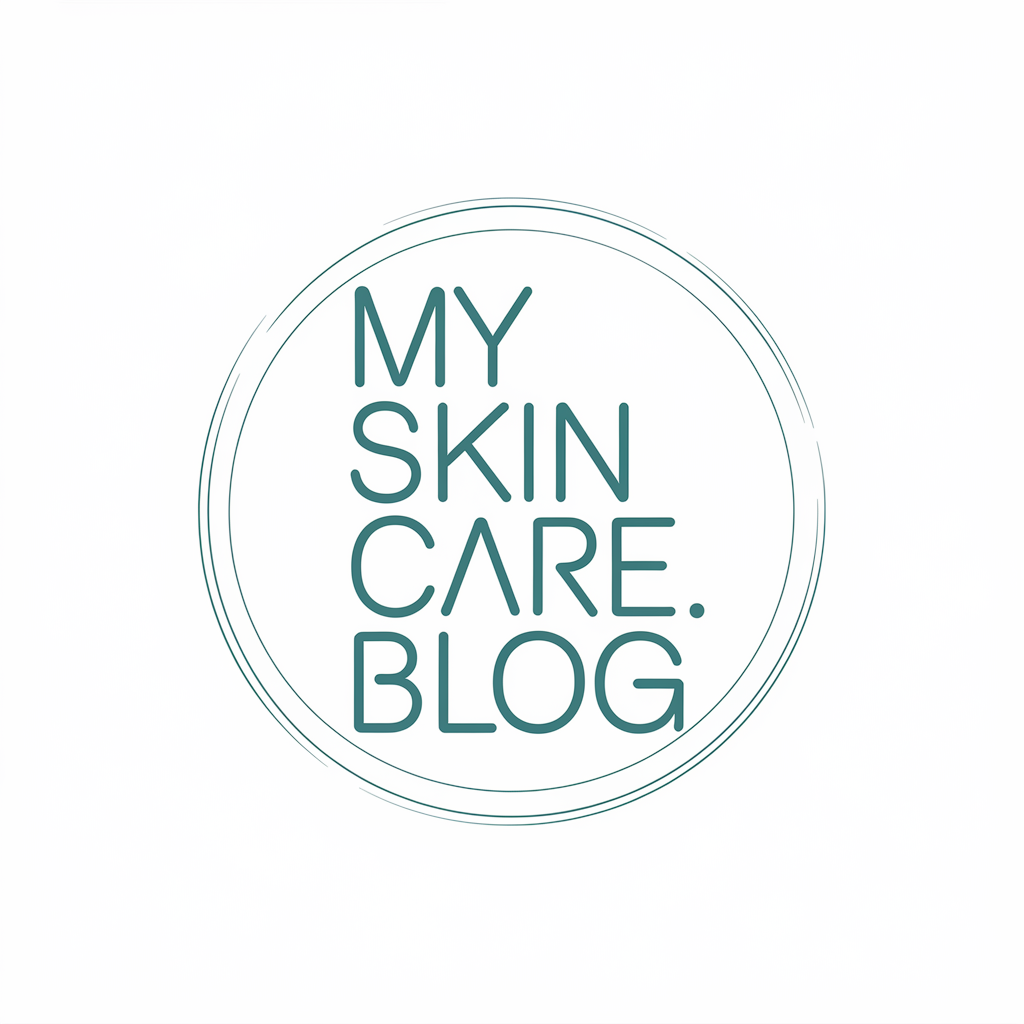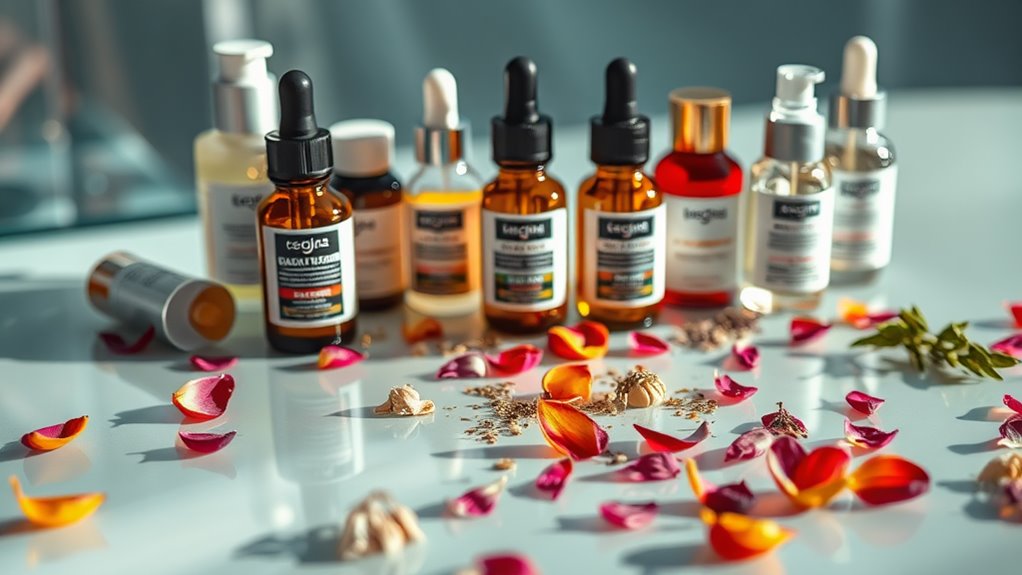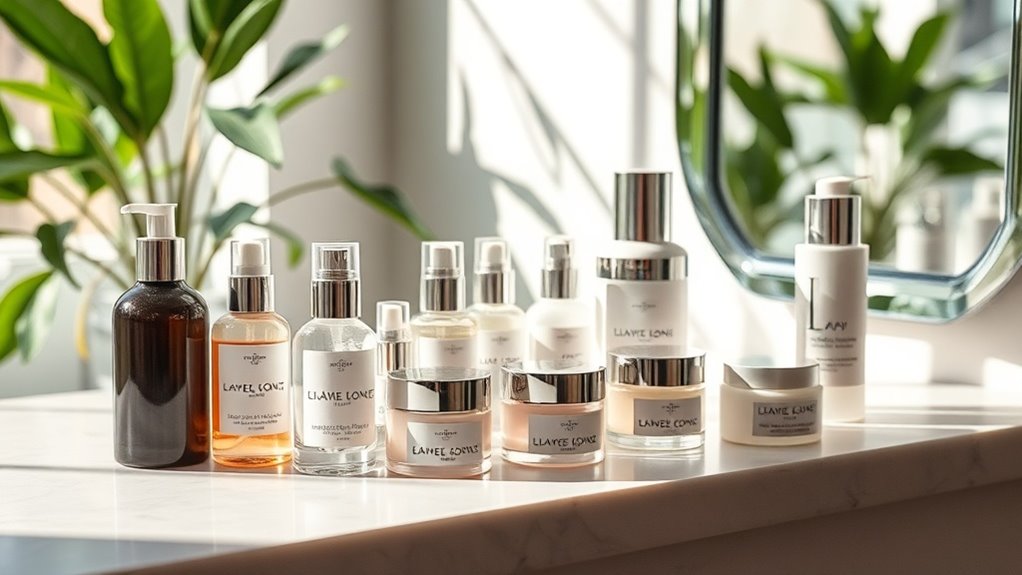Skincare Labels Decoded- What You’re Really Putting on Your Face
When you scan skincare labels, you’re applying actives like hyaluronic acid for deep hydration or niacinamide to brighten and strengthen your skin barrier. Ingredients are listed by concentration, so the first few do the heavy lifting, while natural ones often reduce irritation compared to synthetics. Watch for irritants like fragrances or sulfates that could trigger allergies. By decoding these, you’ll uncover how to pick products that suit your skin type and needs.
Key Takeaways
- Ingredients on skincare labels are listed in descending order, with the first few being the most concentrated.
- Hyaluronic acid hydrates and smooths skin, while niacinamide brightens and strengthens the barrier.
- Natural ingredients like plant extracts often cause less irritation than synthetic ones like parabens.
- Watch for irritants such as fragrance or sulfates, which can cause dryness or allergies.
- Optimal products have a pH of 4-6 to maintain skin’s natural barrier and include acronyms like SPF for sun protection.
Common Ingredients in Skincare Products
When you examine a skincare product’s label, you’ll encounter common ingredients like hyaluronic acid for hydration and salicylic acid for exfoliation.
Label reading empowers you to spot niacinamide for brightening skin and glycerin for moisture retention, both backed by dermatological studies.
You’ll also find antioxidants like vitamin C, which protect against environmental damage, as evidenced in clinical trials.
By mastering label reading, you actively select products that address your needs, ensuring efficacy and safety without unnecessary additives. For instance, some ingredients in face washes can negatively impact different skin types, making it essential to choose formulations that are gentle and tailored to your specific concerns.
This approach enhances your skincare routine’s effectiveness, promoting healthier skin outcomes.
Moreover, these ingredients can be tailored for different skin types, providing customized benefits based on scientific research.
How to Interpret Ingredient Lists
Interpreting an ingredient list starts with noting that ingredients appear in descending order of concentration, as required by regulations like those from the FDA. This means the first ingredient dominates the formula, so you prioritize what’s most prevalent. For example, scan for actives or potential irritants at the top. Moreover, be aware of concentration percentages to gauge the potency of active ingredients.
To emphasize key positions:
| Ingredient Position | What It Means |
|---|---|
| First | Highest concentration; main component |
| Next 2-5 | Significant amounts; key supporters |
| Beyond 5th | Trace levels; minor additives |
You can quickly assess efficacy and safety by focusing on the early entries, making informed choices for your routine.
Additionally, understanding FDA regulations helps protect against misleading marketing tactics in skincare products.
Natural vs. Synthetic Components
When you examine skincare labels, you’ll find that natural components often provide benefits like reduced irritation and better compatibility with your skin’s ecosystem.
These plant-derived ingredients can enhance your routine by offering antioxidants and nutrients backed by botanical research. This compatibility is supported by research into botanical efficacy, ensuring reliable results.
On the other hand, synthetic components may have drawbacks, such as increased risk of allergies or environmental persistence, which you should weigh carefully against their stability and effectiveness.
However, debunking common myths through science-backed research can help clarify that both natural and synthetic ingredients have roles in effective skincare routines.
Benefits of Natural
While synthetic ingredients dominate many skincare formulas for their consistency, natural components offer distinct advantages that enhance skin health and minimize potential irritants.
You gain potent antioxidants from plant extracts like green tea, which actively fight free radicals and boost your skin’s natural defense.
Natural ingredients, such as aloe vera, provide hydration and soothe irritation, drawing on botanical nutrients for renewal.
Evidence from dermatological studies shows they improve elasticity and reduce redness, making your routine more harmonious with your body’s ecosystem.
Embrace these for a gentler, revitalized complexion.
Drawbacks of Synthetic
Synthetic ingredients, while providing reliable consistency in skincare products, often introduce drawbacks that can harm your skin’s health. You might experience irritation or long-term damage from these compounds, as studies link them to inflammation and barrier disruption.
Consider these key issues:
-
Allergic reactions: Synthetics like parabens can trigger sensitivities, increasing redness and itching.
-
Environmental toxins: They persist in ecosystems, potentially contaminating water and affecting biodiversity.
-
Nutrient deficiency: Unlike natural alternatives, synthetics lack vital vitamins and antioxidants, weakening your skin’s defense.
-
Hormone disruption: Chemicals such as phthalates interfere with endocrine function, linked to health risks.
-
Accelerated aging: Overuse builds residue, promoting oxidative stress and premature wrinkles.
Choosing natural options protects your skin’s integrity.
Key Actives and Their Skin Benefits
Key actives form the core of effective skincare, delivering targeted benefits like hydration, anti-aging, or acne control through scientifically proven ingredients such as hyaluronic acid or vitamin C.
You’ll boost your skin’s moisture with hyaluronic acid, which draws in water to plump and smooth fine lines, as clinical studies confirm.
Vitamin C brightens your complexion by neutralizing free radicals, reducing pigmentation per research.
For acne, salicylic acid clears pores by exfoliating dead cells, supported by evidence. Salicylic acid, a beta hydroxy acid, offers additional benefits by penetrating pores to reduce inflammation and prevent future breakouts, as endorsed by dermatologists.
Retinol stimulates collagen, firming your skin against aging, based on authoritative trials.
Choose these wisely for visible results.
To maximize retinol’s effectiveness, incorporate proper application techniques like starting with lower concentrations to reduce potential irritation.
Potential Irritants on Labels
You’ll encounter common skin irritants like fragrances and sulfates on skincare labels, which can trigger reactions in sensitive skin.
You spot these by scanning for warning phrases such as “may cause irritation” or checking ingredient lists carefully.
This awareness lets you choose products that minimize your risk of adverse effects. Understanding the skin barrier damage caused by these irritants can help protect your long-term skin health.
Additionally, exploring safer alternatives can guide you toward a healthier daily beauty routine.
Common Skin Irritants
Ever wondered what ingredients on your skincare labels might irritate your skin?
These common culprits can trigger reactions like redness or itching, backed by dermatological studies. Recognizing them empowers you to choose safer products.
-
Fragrances: Often cause allergic contact dermatitis, as evidence from clinical trials shows.
-
Alcohols: Like ethanol, they strip your skin’s barrier, leading to dryness and inflammation.
-
Sulfates: Such as SLS, which research links to irritation by disrupting natural oils.
-
Parabens: Can provoke sensitivities, with studies noting reactions in susceptible individuals.
-
Essential oils: May inflame sensitive skin, as their potency is well-documented in skin science.
Watch for these to protect your skin’s health.
Identifying Label Warnings
Navigating skincare labels requires spotting potential irritants that could harm your skin, so let’s break down the key warnings based on dermatological research.
You might see phrases like “may cause irritation” or “patch test advised,” which signal risks from sensitizing ingredients. Research from the Journal of the American Academy of Dermatology highlights that labels listing “fragrance,” “essential oils,” or “alcohol” often warn of allergens.
Always note symbols for sensitive skin or EU allergens, as these indicate evidence-based concerns. By recognizing these, you empower informed choices without overlooking hidden threats.
Stay vigilant for your skin’s health.
Avoiding Harmful Ingredients
While common irritants like parabens, sulfates, and synthetic fragrances often appear on skincare labels, you can easily sidestep them by checking for evidence-based red flags from sources such as the American Academy of Dermatology.
These ingredients may trigger allergies or long-term damage, so you’ll want to scrutinize labels actively.
-
Parabens: Linked to endocrine disruption; choose natural alternatives to protect your hormonal health.
-
Sulfates: Strip skin’s natural oils, causing dryness; select gentle, sulfate-free formulas for barrier integrity.
-
Synthetic fragrances: Common allergens; opt for fragrance-free products to reduce sensitivity risks.
-
Formaldehyde releasers: Potential carcinogens; verify absence via certified safe lists for peace of mind.
-
Phthalates: Disrupt skin’s microbiome; prioritize phthalate-free items for overall wellness.
Understanding Ph in Formulations
When you formulate or select skincare products, pH plays a crucial role in determining their effectiveness and safety. It’s a measure of acidity or alkalinity, with your skin’s natural pH around 5.5, acting as a protective barrier. If products deviate, they can cause irritation or impair absorption. Evidence shows matching pH enhances efficacy, as seen in clinical studies.
| pH Range | Skin Impact |
|---|---|
| 4-5 | Optimal for barrier health |
| 5-6 | Balances moisture retention |
| 6-7 | May lead to mild dryness |
| Above 7 | Risks inflammation |
Choose products in the 4-6 range to maintain your skin’s integrity and prevent issues. For optimal results, always be mindful of skincare mistakes that could disrupt this balance and affect your skin’s health. Additionally, aligning product pH with your skin type can help tailor formulations to your specific needs for better overall results.
Decoding Acronyms in Ingredients
Ever wondered how to decipher the acronyms on your skincare labels?
These abbreviations reveal essential ingredient details, helping you make informed decisions. Backed by dermatological research, understanding them empowers safer routines without guesswork.
-
SPF: Sun Protection Factor blocks UV rays, preventing damage and aging.
-
AHA: Alpha Hydroxy Acid exfoliates dead skin cells for smoother texture.
-
BHA: Beta Hydroxy Acid unclogs pores, ideal for acne-prone skin.
-
Niacinamide: A vitamin B3 form that strengthens the skin barrier and evens tone.
-
Hyaluronic Acid: Attracts moisture to hydrate and plump your complexion.
Mastering these ensures you’re applying what truly benefits your skin.
The Function of Preservatives
Preservatives safeguard your skincare products by inhibiting the growth of bacteria, fungi, and other microbes. This essential function prevents contamination, ensuring your formulas remain stable and safe for use.
Scientific evidence confirms that without them, products could spoil quickly, leading to skin irritations or infections. Common types, like parabens or phenoxyethanol, work actively to disrupt microbial cell walls, extending shelf life and maintaining efficacy.
As a savvy consumer, you’re empowered to recognize their role in product integrity, allowing you to choose reliable options for healthier skin care routines.
Ingredients for Different Skin Types
Navigating ingredients for different skin types empowers you to customize your routine effectively, as research shows that factors like oiliness, sensitivity, or dryness dictate what works best.
For example, studies from dermatological journals highlight how selecting the right ingredients can prevent irritation and enhance skin health.
-
Oily skin: Salicylic acid clears pores and controls excess oil, reducing breakouts based on clinical trials.
-
Dry skin: Hyaluronic acid draws in moisture, improving hydration as evidenced by barrier function studies.
-
Sensitive skin: Aloe vera soothes inflammation, minimizing reactions per allergy research.
-
Combination skin: Niacinamide balances oil and moisture, supported by efficacy data.
-
Mature skin: Vitamin C boosts collagen, fighting aging signs through antioxidant evidence.
Choosing Products Based on Labels
Understanding product labels is essential for selecting the right skincare items, as they reveal key ingredients and claims backed by dermatological research. When you’re evaluating labels, prioritize evidence-based ingredients like niacinamide for brightening or ceramides for barrier repair, while steering clear of vague terms like “natural” that lack substantiation. To guide your choices, here’s a breakdown:
| Key Ingredient | Evidence-Based Benefit |
|---|---|
| Hyaluronic Acid | Boosts hydration per clinical trials |
| Retinol | Reduces wrinkles via studies |
| Salicylic Acid | Clears acne based on research |





